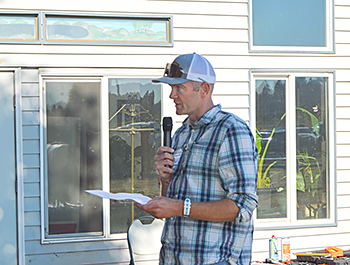Crop Report: Oregon Blueberry Yields and Quality Excel
Good early-season weather set the stage for a good year for Oregon blueberries, according to a crop report at the Oregon State University Blueberry Field Day, July 23 at the North Willamette Research and Extension Center.
“Overall, yield and fruit quality has been good this season,” said T.J. Hafner, Certified Crop Advisor and lead agronomist for AgriCare in Oregon. “There were some huge picks in Duke, like upwards of seven to eight tons per acre, which is incredible.”
 |
T.J. Hafner delivers a crop report at the OSU Blueberry Field Day. |
Early projections were the crop would hit 150 million pounds, but, he said, if yields continue to hold, that could easily be surpassed. “We could easily hit the 150-million pound mark and could be up at that 160 to 165 million pound level,” he said.
Later, at the October Oregon Blueberry Commission meeting, Derek Eisele, vice chairman, said the Oregon blueberry crop for 2025 is estimated at 165 million pounds, up from 153 million pounds in 2024. That would top the state’s record crop of 157 million pounds in 2022.
Key to the development was the good early-season weather, Hafner said. “The weather during bloom was excellent, and fruit set looked good as petal fall and berry sizing began,” he said.
Also, fungal disease pressure was low, and growers were diligent with protecting fruit, he said. “I think growers have been diligent with fungicide sprays,” he said.
Mummy berry incidence was high on some of AgriCare’s organic farms, which cost the company some yield, but not on its conventionally managed farms, Hafner said. And the company was able to minimize issues with spotted wing drosophila, despite higher than normal overwintering populations caused by mild weather during the offseason.
Intense fruit sampling and shortened intervals between sprays have helped on that front, he said. “So far, we haven’t had any issues with spotted wing drosophila,” he said. “I think the heat waves that we have had have helped with this, too.”
The heat waves Hafner referred to could be responsible for some variability in fruit size, however, one of the few negatives for growers this season. “There have been reports of variability in fruit sizing, especially in Draper,” he said. “In our Draper fields I’ve seen more variability in size this season than I ever have. I suspect that this may have been the result of one of those streaks of a few hot days strung together during the fruit-sizing period.”
Hafner also reported that AgriCare saw more issues with the Lecanium scale insect pest this year than in past years, particularly in younger blocks that aren’t usually susceptible to the pest. “This pest in usually more of an issue in older blocks, but we are also finding it in some of our younger blocks, those less than six years old,” he said.
Pruning older canes can help minimize issues with the scale insect, he said, as well as planting hedgerows and using other methods to increase predator insect populations.
Hafner also advised growers to keep an eye out for mealybug, noting that he spotted the pest in some fields for the first time this year. “I had never seen this pest before, and I’m not sure it is going to be an issue, but I know it can be an issue in other regions, and it is certainly something to be watching for.”
“We are all aware that our summers are trending warmer and heat damage is real. At AgriCare, we’re installing evaporative cooling in all of our new developments and also retrofitting systems in some of our older fields.”
|
Near the end of his presentation, Hafner reported that AgriCare has decided to invest in evaporative cooling as a means to mitigate issues with extreme heat. “We are all aware that our summers are trending warmer and heat damage is real,” he said. “At AgriCare, we’re installing evaporative cooling in all of our new developments and also retrofitting systems in some of our older fields.”
He noted that there are agronomic challenges with evaporative cooling in that it creates an environment more favorable for certain disease and insect pests, but AgriCare believes the benefits far exceed the drawbacks. “We are dialing in the system to minimize heat damage, but also not exacerbate other issues,” he said.